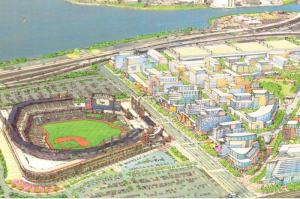
Mayor Bloomberg’s presentation of his budget last week was not an uplifting one. Standing before a room packed full of reporters in the West Wing of City Hall, he clicked through a PowerPoint presentation that made it very clear how bad the city’s fiscal problems are.
Under Mr. Bloomberg’s proposed budget, the city would need to reduce its workforce by more than 10,000 jobs; teachers would be fired; firehouses would be shuttered-the kind of things people really don’t like, and the kinds of things that draw noisy protests to the steps of City Hall.
If these designs are completed, the mayor would leave office with a particularly visible and long-lasting legacy.
What also stood out were the things that did not get cut. Topping that list was the mayor’s four-year infrastructure capital plan, in particular a set of new economic development projects and waterfront parks, funded just as high, or higher, than when they were proposed in headier times. If these pet projects are completed, the mayor could leave office with a particularly visible and long-lasting legacy, budget cuts be damned.
In the capital plan proposed last week, more than $160 million in new funding was earmarked for two planned parks-$110 million for the Williamsburg-Greenpoint waterfront and $55 million for Brooklyn Bridge Park, according to budget documents.
There’s a pattern here. Last year, even as the capital budget underwent a major cut of about 15 percent, the Bloomberg administration pushed ahead on many of the larger (and more expensive) plans already on the drawing board. Indeed, the city’s economic development funds saw less of a reduction than other areas, such as housing, according to figures from the Office of Management and Budget. And the top two projects, Coney Island and Willets Point, which, respectively have $130 million and $380 million listed in the budget, noticeably were not cut at all.
Big spending in the capital budget-which also covers projects like road repair, sewers and new schools and is separate from operating funds-is nothing new for this mayor, who has focused his administration on big modernization projects for the city’s aging infrastructure-$30 billion in city funds over the past four years.
There is an argument to be made that many of these projects pave a way for a better-functioning New York by replacing some of the aging pipes and classrooms that were passed over by prior administrations. New York will, because of the mayor, have a new water treatment plant and put $9 billion toward schools.
But the administration’s approach also has some serious drawbacks, most pointedly with the timing-this year’s capital budget, at about $10 billion, is the highest ever, just as the city’s finances are the worst they have been in years. Since capital spending is generally borrowed, directing money to these projects will increase the city’s hefty debt load, and mean higher debt service for years.
This question has been raised by the nonprofit Citizens Budget Commission, which in a recent report criticized Mr. Bloomberg’s devotion to major economic development projects, particularly since spending on maintenance and repairs citywide-so-called “state of good repair”-appears to have decreased.
The group also noted that the economic development projects tend not to have much public data to back up the argument that the projects will pay off many times over in the future.
“He’s got Willets Point, and he wants to have a big vision and he wants to have a legacy of changing the face of New York, which is understandable, and a good thing to do if you have a lot of resources,” Carol Kellerman, president of CBC, said of Mr. Bloomberg. “But if resources are scarce, which everyone concedes they are, you have to be more parsimonious.
“You’ve got to let state of good repair be the highest priority.”
In response, the Bloomberg administration says that now is not the time to be backing off on big, transformative projects, which, so often in New York’s history, have been derailed by recessions and budget cuts. (See: Moynihan Station.)
“One of the reasons major, long-term projects so often stall is they occur over multiple economic cycles, and it’s easiest for officials to postpone the projects that won’t be completed until long after their term is up,” Andrew Brent, a spokesman for the mayor, said in a statement. “This Administration is committed to making the long-term investments that will help accommodate the City’s future economic and physical growth, while maintaining a record-high capital budget that is creating thousands of jobs for New Yorkers right now.”
This approach is shared by others in government, who generally fear abandoning projects midstream; the M.T.A., for example, is pushing ahead with the Second Avenue Subway and other expansions.
But with the city, it’s significant that for the largest projects-Coney Island and Willets Point-much of the money currently budgeted is for acquisitions, buying up property that the city doesn’t even own.
Given that the money goes into the pockets of a few landlords and businesses, it’s not stimulating much immediate economic activity. Instead, the city is relying on the hope that the projects will be carried out, eventually.
ebrown@observer.com


